A guided tour around The Wallace Collection, Marylebone
The Wallace Collection - situated just off Oxford Street (near round the back of Selfridges) - found in Manchester Square.
It's free to enter, so another great way to spend a couple of hours, but I would definitely recommend joining an expert for one of their daily tours. They're held every day at 14.30 (11am tours on Friday and Sundays too), you're taken round the gallery and stop at specific paintings, furniture, porcelain and other objects of note.
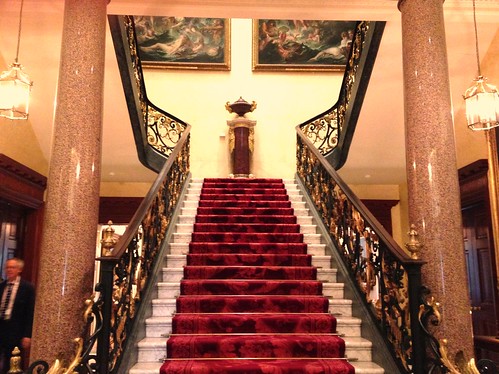
So a bit of background about The Wallace Collection; it's a former townhouse of the Seymour family, Marquesses of Hertford, but nowadays is home to Old Master paintings, fine furniture, arms and armour, and decorative arts from the 15th to the 19th centuries, with a large focus on French 18th century paintings. It was established in 1897 from the private collection created by Richard Seymour-Conway, the 4th Marquess of Hertford, who left the house as well as the art collection to his illegitimate son; Sir Richard Wallace - whose widow then gave the entire collection in the nation. It went on public view in 1900 with the condition that nothing within the collection should leave the house!
We started the tour in the Billiard room, where we were introduced to Louis XIV and his place in history - the 17th century. The room has a number of paintings and sculptures of him and his family, and we were told in great depth about the history of Louis, his impact on art in his period of ruling (think of the BBC Versailles on TV at the moment!). The air was stiff, there was many rules to live by and people had to act in a certain way - very conservative, and the art also followed this style too. Renaissance (initially coming out of Florence, Italy) was the art era, and the room held great examples of beautiful furniture from Andre-Charles Boulle and other highly decorative arts.
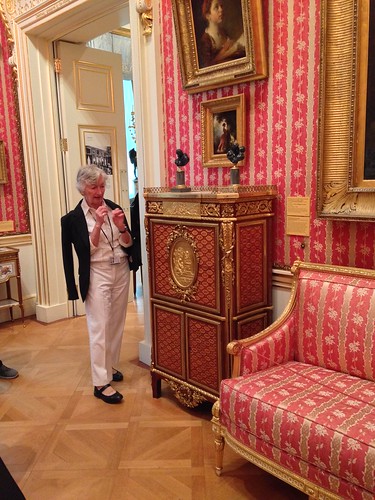
The next room we were led to what the Back State Room, which was a tribute to King Louis XV and his mistress; Madame de Pompadour, so we were now coming into the 18th century. Here we see the emergence of the Rococo art period, this was much more flamboyant, showy, exuberant style. This is one of my favourite art periods, and was a reaction against the strict regulations of the Baroque era, especially the Palace of Versailles. Art in this period showed much more grace, curves, gold and often had more playful, flirty and witty themes. The room is home to many examples of the Porcelain from this era, and the vibrant bright colours which were used - our guide went into great depth on Madame de Pompadours influence too.

This example was commissioned by Louis XV (1739); oak veneers, mahogany drawers, gilt bronze, brass hinges and lock plates, with a serpentine marble top.
Carrying on up the stairs we were treated to a beautiful view of The Rising of the Sun (1753) and The Setting of the Sun (1752), both by Francois Boucher - both commissioned by Madame de Pompadour (The Setting of the Sun sees her as a nymph, welcoming Apollo; God of the Sun - Louis XV - into her arms and to bed I suppose!).

Our guide, with her great knowledge on what seemed the whole of the collection; talked us through many of the paintings throughout the first floor galleries, she was wonderful and gave such a good insight in some of the collection this house holds.
A few more examples, some of which you may recognise;
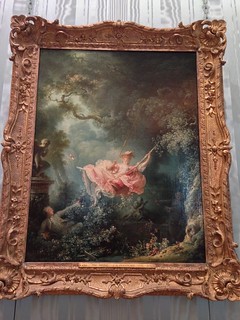
The Swing (1767)by Jean-Honoré Fragonard. Look out for - the ladies husband(?) pushing the her on the swing, how her shoe has accidentally flown off and the young gent taking a cheeky look up her skirt!
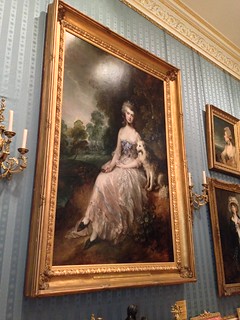
Mrs Mary Robinson (1781) by Thomas Gainsborough. For this portrait we see Mary in morning (note the locket). The story behind this painting is that Mary was an actress, and whilst playing Perdita in The Winters Tale by Shakespeare, George Prince of Wales fell madly in love with her - they were together for a while, she gave up her career, but of course things ended pretty soon. Mary wanted her moneys worth from the breakup, but George wasn't happy giving up a pretty large sum of money! Mary then threatened to publish Georges love letters to her, so he paid eventually. After everything between them, Mary commissioned this painting as a sign of forgiveness from her towards George.
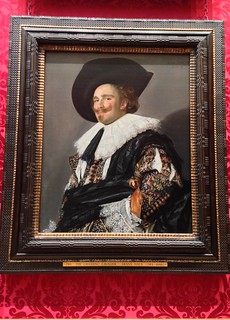
The laughing Cavalier (1624) by Franz Hals, described as "one of the most brilliant of all Baroque paintings". The title was given by the public and press and the man is infact not actually laughing, it's a smile amplified by his upturned moustache.
For centuries the subject was unknown, thought to be a military man (down to what it is wearing and his knife), but is thought now to be a rich civilian, maybe Tieiemanf Roosterman whose family were successful textile merchants.
Look out for the bees, arrows, flaming cornucopia, knots, fire - all associated with love.
I've just given a few examples of tour, we were wandering round for well over an hour and were given in-depth information on so many pieces of art, it was a real insight to the collection here.
Other pieces to look out for there are Rembrandt, the many Canalettos and his followers, pieces from Titian, 9 Rubenses, a few Van Dycks, Bouchers, Gainsborough, Joshua Reynolds, Watteau...I could go on. The collection holds nearly 5,000 objects so there is definitely something there for everyone. They also have a beautiful cafe/restaurant in the centre which is a great place to grab a coffee whilst browsing, or something more substantial.

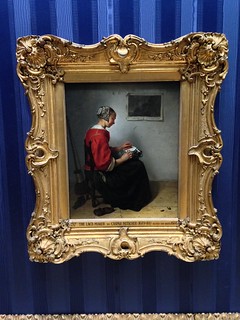
It's free to enter, so another great way to spend a couple of hours, but I would definitely recommend joining an expert for one of their daily tours. They're held every day at 14.30 (11am tours on Friday and Sundays too), you're taken round the gallery and stop at specific paintings, furniture, porcelain and other objects of note.

So a bit of background about The Wallace Collection; it's a former townhouse of the Seymour family, Marquesses of Hertford, but nowadays is home to Old Master paintings, fine furniture, arms and armour, and decorative arts from the 15th to the 19th centuries, with a large focus on French 18th century paintings. It was established in 1897 from the private collection created by Richard Seymour-Conway, the 4th Marquess of Hertford, who left the house as well as the art collection to his illegitimate son; Sir Richard Wallace - whose widow then gave the entire collection in the nation. It went on public view in 1900 with the condition that nothing within the collection should leave the house!
We started the tour in the Billiard room, where we were introduced to Louis XIV and his place in history - the 17th century. The room has a number of paintings and sculptures of him and his family, and we were told in great depth about the history of Louis, his impact on art in his period of ruling (think of the BBC Versailles on TV at the moment!). The air was stiff, there was many rules to live by and people had to act in a certain way - very conservative, and the art also followed this style too. Renaissance (initially coming out of Florence, Italy) was the art era, and the room held great examples of beautiful furniture from Andre-Charles Boulle and other highly decorative arts.

The next room we were led to what the Back State Room, which was a tribute to King Louis XV and his mistress; Madame de Pompadour, so we were now coming into the 18th century. Here we see the emergence of the Rococo art period, this was much more flamboyant, showy, exuberant style. This is one of my favourite art periods, and was a reaction against the strict regulations of the Baroque era, especially the Palace of Versailles. Art in this period showed much more grace, curves, gold and often had more playful, flirty and witty themes. The room is home to many examples of the Porcelain from this era, and the vibrant bright colours which were used - our guide went into great depth on Madame de Pompadours influence too.

This example was commissioned by Louis XV (1739); oak veneers, mahogany drawers, gilt bronze, brass hinges and lock plates, with a serpentine marble top.
Carrying on up the stairs we were treated to a beautiful view of The Rising of the Sun (1753) and The Setting of the Sun (1752), both by Francois Boucher - both commissioned by Madame de Pompadour (The Setting of the Sun sees her as a nymph, welcoming Apollo; God of the Sun - Louis XV - into her arms and to bed I suppose!).

Our guide, with her great knowledge on what seemed the whole of the collection; talked us through many of the paintings throughout the first floor galleries, she was wonderful and gave such a good insight in some of the collection this house holds.
A few more examples, some of which you may recognise;

The Swing (1767)by Jean-Honoré Fragonard. Look out for - the ladies husband(?) pushing the her on the swing, how her shoe has accidentally flown off and the young gent taking a cheeky look up her skirt!

Mrs Mary Robinson (1781) by Thomas Gainsborough. For this portrait we see Mary in morning (note the locket). The story behind this painting is that Mary was an actress, and whilst playing Perdita in The Winters Tale by Shakespeare, George Prince of Wales fell madly in love with her - they were together for a while, she gave up her career, but of course things ended pretty soon. Mary wanted her moneys worth from the breakup, but George wasn't happy giving up a pretty large sum of money! Mary then threatened to publish Georges love letters to her, so he paid eventually. After everything between them, Mary commissioned this painting as a sign of forgiveness from her towards George.

The laughing Cavalier (1624) by Franz Hals, described as "one of the most brilliant of all Baroque paintings". The title was given by the public and press and the man is infact not actually laughing, it's a smile amplified by his upturned moustache.
For centuries the subject was unknown, thought to be a military man (down to what it is wearing and his knife), but is thought now to be a rich civilian, maybe Tieiemanf Roosterman whose family were successful textile merchants.
Look out for the bees, arrows, flaming cornucopia, knots, fire - all associated with love.
I've just given a few examples of tour, we were wandering round for well over an hour and were given in-depth information on so many pieces of art, it was a real insight to the collection here.
Other pieces to look out for there are Rembrandt, the many Canalettos and his followers, pieces from Titian, 9 Rubenses, a few Van Dycks, Bouchers, Gainsborough, Joshua Reynolds, Watteau...I could go on. The collection holds nearly 5,000 objects so there is definitely something there for everyone. They also have a beautiful cafe/restaurant in the centre which is a great place to grab a coffee whilst browsing, or something more substantial.


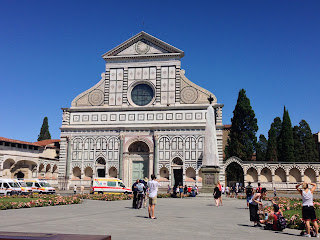
Comments
Post a Comment